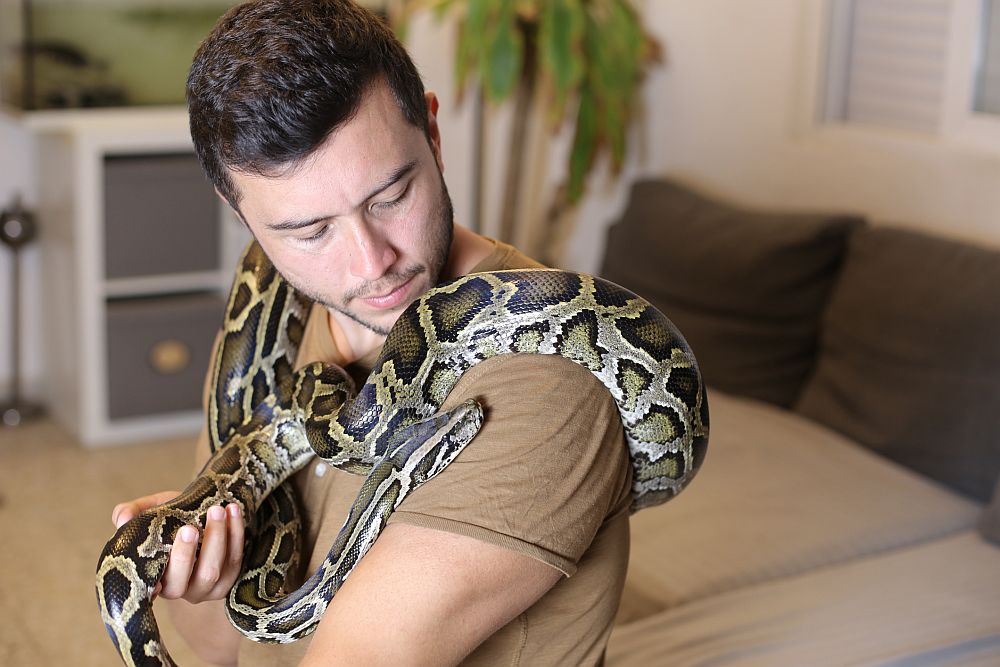Table of Contents
Burmese Pythons are large, powerful snakes that require a specific diet to thrive in captivity. Providing the right nutrition is crucial for their health and well-being. This feeding guide for Burmese Pythons covers the top seven essential tips to ensure your python receives the proper care and nutrition.

Top Tips for Feeding Burmese Pythons
1. Understand Their Natural Diet
In the wild, Burmese Pythons are opportunistic feeders, preying on a variety of animals such as birds, mammals, and occasionally reptiles. In captivity, they can be fed a diet of appropriately sized rodents, such as rats and rabbits. For more on their natural diet, visit Reptiles Magazine Burmese Python Care Sheet.
2. Feed Appropriately Sized Prey
The size of the prey should be proportional to the size of your python. A good rule of thumb is to offer prey that is about the same width as the widest part of your python’s body. Feeding prey that is too large can cause digestive issues, while too small prey may not provide adequate nutrition. For sizing guidelines, see The Spruce Pets Burmese Python Care Sheet.
3. Establish a Feeding Schedule
Young Burmese Pythons should be fed once a week, while adults can be fed every two to three weeks. Overfeeding can lead to obesity and related health issues, so it’s important to maintain a regular feeding schedule based on your python’s age and size. For more on feeding schedules, visit PetMD Burmese Python Care.
4. Ensure Proper Thawing of Frozen Prey
If you are using frozen prey, ensure it is properly thawed before feeding it to your python. Thaw the prey in a refrigerator overnight or in a sealed bag submerged in warm water. Never use a microwave to thaw prey, as it can create hot spots that may harm your python. For safe thawing tips, see Reptiles Magazine Safe Feeding.
5. Use Feeding Tongs
To avoid accidental bites, use long feeding tongs to offer prey to your Burmese Python. This also helps to establish a feeding routine and prevents your python from associating your hands with food. For more on safe feeding practices, visit The Spruce Pets Feeding Snakes.
6. Monitor Your Python’s Health
Regularly monitor your python’s health and weight. A healthy Burmese Python should have a rounded body and be active. If you notice any signs of illness, such as weight loss, lethargy, or changes in appetite, consult a veterinarian experienced with reptiles. For health monitoring tips, see Anapsid Burmese Python Care.
7. Provide Fresh Water
Always provide fresh water for your Burmese Python. The water dish should be large enough for the python to soak in, as soaking aids in hydration and shedding. Clean the water dish regularly to prevent bacterial growth. For more on hydration, visit ReptiFiles Burmese Python Care.
Conclusion on Feeding Guide for Burmese Pythons
Providing the right diet and care for your Burmese Python is essential for their health and well-being. By following these top seven tips in this feeding guide for Burmese Pythons, you can ensure your python remains healthy and thriving. Remember to consult with a veterinarian for personalized advice and regular check-ups. For more tips on reptile care, check out our Pet Care Guide.
FAQs on Feeding Guide for Burmese Pythons
How often should I feed my young Burmese Python?
Young Burmese Pythons should be fed once a week. This frequent feeding supports their rapid growth and development.
What type of prey is best for adult Burmese Pythons?
Adult Burmese Pythons can be fed larger prey such as rats and rabbits. The prey size should be proportional to the python’s body width.
Can I feed my Burmese Python live prey?
It is generally recommended to feed frozen-thawed prey to prevent injury to your python. Live prey can bite and injure your snake during feeding.
How do I know if my Burmese Python is overweight?
A healthy Burmese Python should have a rounded body without excessive bulges or rolls. If your python appears overly round or has difficulty moving, it may be overweight.
What should I do if my Burmese Python refuses to eat?
If your python refuses to eat, ensure the prey is appropriately sized and properly thawed. If refusal continues, consult a veterinarian to rule out health issues.
How can I ensure my python’s water is clean?
Clean the water dish regularly and replace it with fresh water daily. Ensure the dish is large enough for soaking and is cleaned with mild, pet-safe disinfectants.











